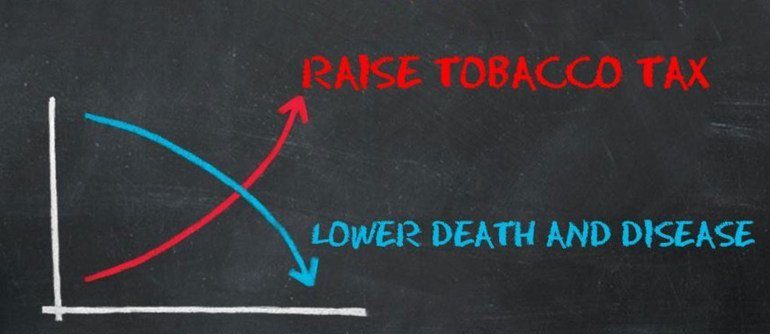
Price and tax measures are the most effective measures to reduce demand for tobacco products. The significant increases in excise taxes on tobacco products that lead to price increases have steadily proven to be the most cost-effective method for reducing tobacco consumption and plummeting its associated health and economic burden worldwide. Higher prices of tobacco products encourage cessation and prevent initiation of tobacco use.
WHO study reveals that on average a 10 % price increase on a pack of cigarettes would be expected to reduce demand for cigarettes by about 4 % in high-income countries and by about 5% in low – and middle countries, where lower incomes tend to make people more sensitive to price changes.
Key facts:
Even though Nepal was the first country in the South –East Region to impose the dedicated levy on tobacco products as a health tax, Nepal has the lowest tax rate among South Asian Countries (Bangladesh -71%, Maldives -69 %, Sri Lanka – 66%, Pakistan-56%, India 54%) i.e. 30 % as a percentage of the retail price. The Nepal government levies exercise tax on tobacco products every year. However, the tax growth rate is negligible. Hence, there is significant room for tax increment in Nepal.
Excise Duty on Tobacco: Research studies support the evidence that increase in tax and prices of tobacco products are the most cost effective measure to reduce tobacco consumption. Increased Tobacco taxation particular increases the retail price of tobacco products and thus, reduces the demand especially among the youth and the poor1.
In the midst of the pandemic’s catastrophic second wave, the government of Nepal has presented federal budget for the forthcoming fiscal year 2021/22 (2078/2079) on May 29, 2021 and mentioned around 25% hike in excise tax on Tobacco Products. (Annex 1)
It has been hailed by few government officials as a big achievement in terms of tobacco tax increment compared to previous year’s growth. While 25 percentage increases appears to be high, it is not a large increment in real terms, and it is not radical change as expected by the tobacco control advocates.
Tobacco products are taxed in Nepal in three different ways: excise duty, health hazard tax, and value-added tax (VAT). The 25% increase in excise duty would hardly make any difference. The current excise duty on the most popular tobacco brand, excluding health hazard tax and VAT, is around 16.18 percent2. When this year’s 25% increment is adjusted, the excise tax would reach to around 20 percent. The health hazard tax is around 4.8%, and when combined with the 13% VAT, the total tax on tobacco is around 38% of the retail price which, again, ranks Nepal lowest among South Asian countries in terms of tobacco tax3. However, the WHO advises that tobacco taxes be increased up to 70% of the retail price.
Excise Duty on Alcohol: Nepal government has also announced to increase excise duty on Alcohol products in the budget 2021-2020. In comparison to the previous year, excise duty on Alcohol has increased by around 20% in 2021. (Annex 2)
What had been done to influence policy makers to increase tax?
We conducted workshop, webinars, and media advocacy programs to raise government’s awareness, and gain commitment to increase tax on tobacco products. In addition, we held one to one meeting with law/policy makers, political leaders, and media personality to encourage them to advocate for tobacco tax increment in the budget 2021/2022.
What was tobacco industry’s influence to block the increment or keep traditional increment?
TI has always worked to interfere to block the tax increase or to stick with the existing rate. This year, in the midst of the COVID-19 outbreak, TI donated to facilitate health system of numerous government hospitals to combat the pandemic. Apart from that, Surya Nepal Pvt. Ltd. had donated NPR 10 million each province (total NPR 70 million) to the “Funds for treatment and control COVID-19” established by all seven provinces in Nepal. 4
Mr. Ananad Bahadur Chand, Chairperson of Action Nepal, stated, “Despite the pressure from all stakeholders involved, the government has hiked the excise duty on tobacco only by 25%, including inflation. When inflation is taken into account, the overall exercise tax for this year will be between 36 and 37 percent of the retail price, which is slightly more than last year but still it remains among the lowest in South Asia.
Burden of tobacco use in Nepal: Annually, tobacco kills around 27,137 people (accounted for 14.9 % of all deaths) in Nepal5. According to Nepal STEPS survey 2019, 28.9% of adults 15-69 years of age (48.3% of men, 11.6% of women) were current users of tobacco, in any form, and this is equal to 3.8 million adults6. Tobacco costs Nepal NPR 47 billion every year, which is equivalent to 1.8% of GDP.
For More Details Click Here